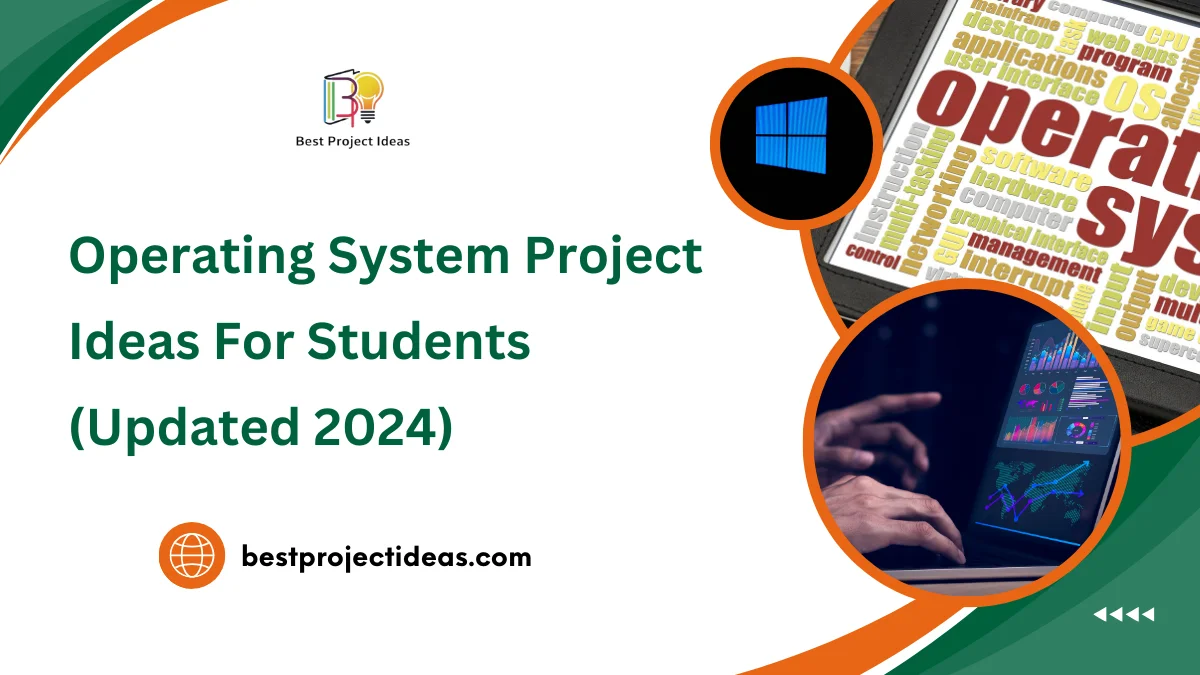
Operating systems quietly keep our computers running smoothly daily, like traffic managers for our apps.
Understanding operating systems is essential in computer science because it shows how computers and software work together.
Exploring Operating System Project Ideas for Students is a great way to learn and practice coding skills. This blog will discuss different project ideas for all skill levels, giving tips and resources to help you start your OS journey.
What Are OS Projects?
OS projects are about developing, maintaining, or improving operating systems. An operating system is essential software that manages computer hardware and software resources and provides standard services for computer programs. Here are some essential parts of OS projects:
Types:
- Open-source projects (e.g., Linux, FreeBSD)
- Proprietary projects (e.g., Windows, macOS)
- Research or academic projects
Goals:
- Creating new operating systems
- Enhancing existing OS functionality
- Improving performance and security
- Adding support for new hardware
Components often involved:
- Kernel development
- Device driver creation
- File system management
- User interface design
- Security implementations
Examples of notable OS projects:
- Linux kernel and its various distributions
- Android (mobile OS based on Linux)
- ReactOS (open-source Windows-compatible OS)
- Fuchsia (Google’s experimental OS)
Community involvement:
- Many open-source OS projects rely on community contributions
- Developers worldwide collaborate on improvements and bug fixes
OS projects can range from large-scale efforts by big tech companies to small, specialized systems designed for specific purposes or devices.
Also Read: 21+ New GCP Project Ideas For Beginners (Updated 2025)
What Are The 5 Examples Of Operating Systems?
Here are five examples of operating systems:
- Windows
Windows is a popular operating system made by Microsoft. It’s easy to use and familiar on personal computers and laptops.
- macOS
MacOS is Apple’s operating system for Mac computers. It’s known for its nice design and works well with other Apple devices and services.
- Linux
Linux is an open-source operating system with many versions (like Ubuntu, Fedora, and Debian). It’s known for being flexible and secure.
- Android
Android is a mobile operating system made by Google. It’s used on many smartphones and tablets from different makers.
- iOS
iOS is Apple’s mobile operating system for iPhones and iPads. It’s known for working smoothly and fitting well with Apple’s other products.
These operating systems work on different devices, from personal computers to mobile devices, each with strengths and usual uses.
Top-Level Operating System Project Ideas For Students
Here are one of the best OS Project Ideas For Students:
File Systems
- Quantum-Resistant File System
Make a file system with quantum-resistant encryption to protect against future quantum computer attacks. It should use lattice-based cryptography for key exchange and signatures.
- DNA Storage File System
Create a file system that can store data in synthetic DNA molecules. It should handle encoding digital data into DNA sequences and reading it back.
- Time-Travel File System
Design a file system that keeps all versions of files, allowing users to “travel back in time” to see older versions. It should use intelligent compression to save space.
Memory Management
- Holographic Memory Manager
Build a memory manager for systems using holographic storage. It should handle addressing and retrieval from 3D holographic memory crystals.
- Brain-Inspired Memory Allocation
Create a memory allocator that mimics how human brains store memories. It should use associative addressing and strengthen frequently accessed “neural pathways.”
- Smell-Based Memory Organizer
Develop a memory organization system inspired by how smells trigger memories in humans. It should group related data based on abstract “scent” signatures.
Process Scheduling
- Empathy-Driven Scheduler
Design a process scheduler that uses machine learning to understand user emotions and prioritize tasks that improve mood. It should read facial expressions or voice tones.
- Eco-Friendly Task Manager
Build a scheduler that balances performance with energy use. It should favor low-power tasks when the battery is low or during peak electricity hours.
- Fairytale Quest Scheduler
Create a process scheduler that turns tasks into a fantasy adventure. It should assign “quests” to “heroes” (processes) based on their “skills” (resource needs).
Device Drivers
- Thought-Controlled Input Driver
Develop a driver for brain-computer interfaces that allow users to control computers with thoughts. It should translate brain signals into keyboard and mouse inputs.
- Smell-O-Vision Output Driver
Make a driver for devices that can produce smells. It should convert digital “smell codes” into commands for scent-generating hardware.
- Haptic Hologram Driver
Create a driver for devices that project touchable holograms. It should manage visual projection and force feedback for “solid” holograms.
Networking
- Quantum Entanglement Network Stack
Design a network stack for quantum computers that use entangled particles to send data. It should handle qubit state preparation and measurement.
- Interplanetary File Transfer Protocol
Develop a file transfer protocol for communication between planets. It should account for long delays and manage data corruption from cosmic rays.
- Dream-to-Dream Network Protocol
Create a protocol for sharing information between people’s dreams. It should encode dream content and sync it with other sleepers.
Security
- DNA-Based Authentication System
Build an authentication system that uses a person’s DNA as a password. It should securely hash genetic markers to create unforgeable biokeys.
- Quantum Key Distribution Manager
Develop a key management system using quantum key distribution. It should work with quantum hardware to create unbreakable encryption keys.
- Time Travel Intrusion Detection
Design an intrusion detection system that can spot attackers in the future. It should look for impossible knowledge or tech in system activities.
User Interface
- Synesthesia Desktop Environment
Create a desktop environment for people with synesthesia. It should allow users to navigate by color-sound or taste-shape associations.
- Dreamscape Window Manager
Develop a window manager that organizes apps in a dream-like space. It should use surreal transitions and impossible geometry for app switching.
- Tactile GUI for the Blind
Build a graphical interface that can be fully experienced through touch. It should use dynamic Braille displays and 3D-printed UI elements.
Virtualization
- Multiverse Hypervisor
Design a hypervisor that runs VMs in parallel universes. It should leverage quantum effects to execute operations in multiple realities.
- Time Dilation Container Runtime
Create a container system to speed up or slow down the time inside containers. It should allow long tasks to finish quickly in “fast time” zones.
- Dream State Virtual Machine
Develop a VM that runs in a person’s dreams. It should interface with sleep monitoring devices to execute code during REM sleep.
Power Management
- Photosynthesis-Based Power Manager
Build a power management system for devices with built-in plant matter. It should optimize sunlight exposure and manage energy from photosynthesis.
- Cosmic Ray Energy Harvester
Create an energy system that captures power from cosmic rays. It should work with special hardware to turn particle strikes into usable energy.
- Perpetual Motion Process Scheduler
Design a scheduler that can run processes forever without external power. It should balance workloads to maintain a theoretical perpetual motion machine.
Embedded Systems
- Tardigrade-Based Nanocomputer OS
Develop an OS for computers small enough to fit inside a tardigrade. It should manage the tardigrade’s biological functions while running code.
- Quantum Dot Display Driver
Create a display driver for screens made of quantum dots. It should control individual atoms to create images at the smallest possible scale.
- Neural Dust Operating System
Build an OS for tiny “neural dust” particles in the brain. It should manage power, communication, and neural signal processing for brain-computer interfaces.
Distributed Systems
- Mycelium Network File System
Design a distributed file system that uses living fungal networks. It should encode data as chemical signals and use mycelium for transmission.
- Collective Consciousness Compute Cluster
Develop a distributed computing system that links human minds. It should break down problems and use connected brains as parallel processors.
- Exoplanet Distributed Database
Create a database system spread across multiple planets. It should handle extreme latency and manage consistency across light-years of space.
Real-time Systems
- Time Crystal-Based RTOS
Build a real-time OS using time crystals for perfect timing. It should leverage the repeating states of time crystals for ultra-precise scheduling.
- Precognition-Driven Task Scheduler
Design a scheduler that predicts future events and pre-emptively allocates resources. It should use quantum effects to glimpse likely futures.
How Do I Make An Operating System Project?
Creating an operating system project is a complex and challenging task. Here’s a high-level overview of the process:
- Choose a development environment: Select a programming language (often C or assembly) and development tools.
- Start with a bootloader: Write code that initializes the system when powered on.
- Implement a kernel: Develop the core of your OS that manages hardware resources.
- Add basic drivers: Write software to communicate with essential hardware components.
- Develop a file system: Create a way to organize and store data on storage devices.
- Implement memory management: Design how your OS will allocate and manage memory.
- Add process management: Develop a system for creating, scheduling, and terminating processes.
- Create a basic shell: Develop a user interface for interacting with your OS.
- Implement networking: Add capabilities for network communication if desired.
- Test and debug: Thoroughly test your OS in various scenarios and fix issues.
10 Popular Tools For Creating OS Projects
- Git
Distributed version control system for tracking changes in source code.
- GitHub
Web-based platform for hosting and collaborating on Git repositories.
DevOps platform that provides Git repository management and CI/CD pipelines.
- Visual Studio Code
Lightweight, extensible code editor with built-in Git support.
- Jenkins
Open-source automation server for building, testing, and deploying code.
- Docker
A platform for developing, shipping, and running applications in containers.
- Jira
Project management tool for agile software development and issue tracking.
- Travis CI
Continuous integration service for building and testing projects hosted on GitHub.
- Maven
Build automation and project management tools for Java projects.
- Kubernetes
Open-source container orchestration platform for automating deployment and scaling.
Skills Gained from OS Projects
Skills gained from OS projects include:
- Low-level programming: Understanding computer parts and assembly language.
- Memory management: Skill in efficiently using and freeing up system resources.
- Process scheduling: Knowing how to manage multiple processes at the same time.
- Device driver development: Ability to write software that works directly with hardware.
- File system design: Understanding how to store and find data.
- Networking protocols: Knowledge of how to set up and manage network communication.
- Security implementation: Skills in keeping the system and user data safe.
- Debugging complex systems: Advanced problem-solving in systems with limited resources.
- Performance optimization: Ways to make the system work faster and better.
- Systems architecture: Understanding how different parts of a computer system work together.
Final Words
Operating system project ideas are a great way to learn how computers work. These projects help you understand the main parts of a computer. As you learn more, you can try more challenging projects.
These activities make learning about operating systems fun and easy. You’ll see how different parts of a computer work together. With operating system project ideas, you can explore and discover new things about computers. It’s a fun way to grow your skills and knowledge step by step.

